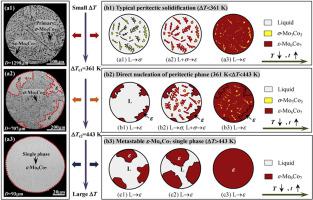当前位置:
X-MOL 学术
›
Intermetallics
›
论文详情
Our official English website, www.x-mol.net, welcomes your feedback! (Note: you will need to create a separate account there.)
Rapid growth kinetics and microstructure modulation of intermetallic compounds within containerlessly solidifying Mo-Co refractory alloys
Intermetallics ( IF 4.4 ) Pub Date : 2020-10-01 , DOI: 10.1016/j.intermet.2020.106886 S. Sha , W.L. Wang , J. Chang , Y.H. Wu , S.S. Xu , B. Wei
Intermetallics ( IF 4.4 ) Pub Date : 2020-10-01 , DOI: 10.1016/j.intermet.2020.106886 S. Sha , W.L. Wang , J. Chang , Y.H. Wu , S.S. Xu , B. Wei

|
Abstract To explore an innovative approach to prepare high-performance Mo-based refractory alloys, the rapid solidification mechanisms of undercooled Mo-40%Co hyperperitectic alloy were investigated by both electromagnetic levitation (EML) and drop tube (DT) techniques. During EML experiments, typical peritectic solidification still prevailed even at the maximum undercooling of 252 K (0.14 TL). The dendrite growth velocity of primary σ-Mo3Co2 compound varied with alloy undercooling by a power relation, which attained 24.3 mm s−1. As the bulk undercooling increased, the conspicuous dendrite fragmentation of primary phase took place, resulting in its grain refinement and volume fraction reduction. Meanwhile, the second recalescence degree exhibited a decreasing tendency, which indicated that the peritectic reaction was remarkably suppressed in the undercooled state. Under free fall condition, two critical diameters were determined for tiny alloy droplets and the corresponding undercooling thresholds were calculated as 361 and 443 K, respectively. When the alloy droplet was larger than 707 μm, the typical peritectic solidification proceeded and the final microstructure was composed of primary σ-Mo3Co2 dendrites and interdendritic e-Mo6Co7 peritectic phase. With the reduction of droplet diameter, the direct nucleation of peritectic phase was induced. In this case, the e-Mo6Co7 intermetallic compound regions appeared preferentially at the periphery of alloy droplets, whereas the typical peritectic microstructure filled in the center area. Once the droplet diameter decreased to 93 μm, the peritectic solidification characteristics disappeared completely and the metastable e-Mo6Co7 single phase became the unique growth morphology.
中文翻译:

无容器凝固钼钴耐火合金中金属间化合物的快速生长动力学和微观结构调节
摘要 为了探索制备高性能钼基难熔合金的创新方法,通过电磁悬浮(EML)和落管(DT)技术研究了过冷Mo-40%Co超包晶合金的快速凝固机制。在 EML 实验期间,即使在 252 K (0.14 TL) 的最大过冷度下,典型的包晶凝固仍然占主导地位。初级σ-Mo3Co2 化合物的枝晶生长速度随合金过冷度呈幂关系变化,达到24.3 mm s-1。随着整体过冷度的增加,初生相发生明显的枝晶破碎,导致其晶粒细化和体积分数降低。同时,第二次再发光程度呈下降趋势,这表明在过冷状态下包晶反应受到显着抑制。在自由落体条件下,确定了微小合金液滴的两个临界直径,相应的过冷阈值分别计算为 361 和 443 K。当合金液滴大于 707 μm 时,进行典型的包晶凝固,最终显微组织由初生 σ-Mo3Co2 枝晶和枝晶间 e-Mo6Co7 包晶相组成。随着液滴直径的减小,包晶相直接成核。在这种情况下,e-Mo6Co7 金属间化合物区域优先出现在合金液滴的外围,而典型的包晶组织填充在中心区域。一旦液滴直径减小到 93 μm,
更新日期:2020-10-01
中文翻译:

无容器凝固钼钴耐火合金中金属间化合物的快速生长动力学和微观结构调节
摘要 为了探索制备高性能钼基难熔合金的创新方法,通过电磁悬浮(EML)和落管(DT)技术研究了过冷Mo-40%Co超包晶合金的快速凝固机制。在 EML 实验期间,即使在 252 K (0.14 TL) 的最大过冷度下,典型的包晶凝固仍然占主导地位。初级σ-Mo3Co2 化合物的枝晶生长速度随合金过冷度呈幂关系变化,达到24.3 mm s-1。随着整体过冷度的增加,初生相发生明显的枝晶破碎,导致其晶粒细化和体积分数降低。同时,第二次再发光程度呈下降趋势,这表明在过冷状态下包晶反应受到显着抑制。在自由落体条件下,确定了微小合金液滴的两个临界直径,相应的过冷阈值分别计算为 361 和 443 K。当合金液滴大于 707 μm 时,进行典型的包晶凝固,最终显微组织由初生 σ-Mo3Co2 枝晶和枝晶间 e-Mo6Co7 包晶相组成。随着液滴直径的减小,包晶相直接成核。在这种情况下,e-Mo6Co7 金属间化合物区域优先出现在合金液滴的外围,而典型的包晶组织填充在中心区域。一旦液滴直径减小到 93 μm,



























 京公网安备 11010802027423号
京公网安备 11010802027423号